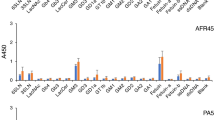Summary
We have characterized the effects of serum andN-acetylglucosamine in a glucose-deprived condition on the glycosylation of antibody light chains, as well as the resulting biological properties of those antibodies. We have chosen for our investigation the human hybridoma lines producing monoclonal antibodies reactive to lung adenocarcinoma. Each antibody possess aN-glycosylated carbohydrate chain in the hypervariable region of the light chains. When the cell lines were grown in the absence of glucose, variant light chains with varying molecular masses were found to be secreted. Analysis of these light chains produced in a glucose-deprived condition revealed that the changed molecular-mass of the variant light chains is due to different glycosylation. Addition ofN-acetylglucosamine or fetal calf serum to the glucose-free medium led to the creation of other light chains that exhibit increased antigen binding activity.
Similar content being viewed by others
References
Chothia, C.; Lesk, A. M. Canonical structures for the hypervariable regions of immunoglobulins. J. Mol. Biol. 196:901–917; 1987.
Clamp, J. R.; Bernier, G. M.; Putnam, F. W. Source of the apparent carbohydrate content of bence-jones proteins. Biochim. Biophys. Acta 86:149–155; 1964.
Curling, E. M. A.; Hayter, P. M.; Baines, A. J., et al. Recombinant human interferon-γ. Biochem. J. 272:333–337; 1990.
Gauny, S. S.; Andya, J.; Thomson, J., et al. Effect of production method on the systemic clearance rate of a human monoclonal antibody in the rat. Hum. Antib. Hybrid. 2:33–38; 1991.
Hashizume, S.; Kamei, M.; Mochizuki, K., et al. Serodiagnosis of cancer by usingCandida cytochromec recognized by human monoclonal antibody HB4C5. Hum. Antib. Hybrid. 2:142–147; 1991.
Hashizume, S.; Mochizuki, K.; Kamei, M., et al. Serodiagnosis of cancer, using porcine carboxypeptidase A as an animal antigen recognized by human monoclonal antibody HB4C5. Hum. Antib. Hybrid. 2:150–155; 1991.
Kato, M.; Mochizuki, K.; Hashizume, S., et al. Activity enhancement of a lung cancer-associated human monoclonal antibody HB4C5 byN-deglycosylation. Hum. Antib. Hybrid. 4:9–14; 1993.
Kato, M.; Mochizuki, K.; Kuroda, K., et al. Histone H2B as an antigen recognized by lung cancer-specific human monoclonal antibody HB4C5. Hum. Antib. Hybrid. 2:94–101; 1991.
Koide, N.; Nose, M.; Muramatsu, T. Recognition of IgG by Fc receptor and complement: effects of glycosidase digestion. Biochem. Biophys. Res. Commun. 75:838–844; 1977.
Laemmli, U. K. Cleavage of structural proteins during assembly of head of bacteriophage-T4. Nature 227:680–685; 1970.
Murakami, H.; Hashizume, S.; Ohashi, H., et al. Human-human hybridomas secreting antibodies specific to human lung carcinoma. In Vitro Cell. Dev. Biol. 21:593–596; 1985.
Murakami, H.; Masui, H.; Sato, G., et al. Growth of hybridoma cells in serum-free medium: ethanolamine is an essential component. Proc. Natl. Acad. Sci. USA 79:575–583; 1982.
Novick, K. E.; Fasy, T. M.; Losman, M. J., et al. Polyreactive IgM antibodies generated from autoimmune mice and selected for histone-binding activity. Int. Immunol. 4:1103–1111; 1992.
Rearick, J. I.; Chapman, A.; Kornfeld, S. Glucose starvation alters lipid-linked oligosaccharide biosynthesis in chinese hamster ovary cells. J. Biol. Chem. 256:6255–6261; 1981.
Sibley, C. H.; Wagner, R. A. Glycosylation is not required for membrane localization or secretion of IgM in a mouse B cell lymphoma. J. Immunol. 126:1868–1873; 1981.
Sox, H. C., Jr.; Hood, L. Atlachment of carbohydrate to the variable region of myeloma immunoglobulin light chains. Proc. Natl. Acad. Sci. USA 66:975–982; 1970.
Stark, N. J.; Heath, E. C. Glucose-dependent glycosylation of secretory glycoprotein in mouse myeloma cells. Arch. Biochem. Biophys. 192:599–609; 1979.
Tachibana, H.; Seki, K.; Murakami, H. Identification of hybrid-type carbohydrate chains on the light chain of human monoclonal antibody specific to lung adenocarcinoma. Biochim. Biophys. Acta. 1182:257–263; 1993.
Tachibana, H.; Shirahata, S.; Murakami, H. Generation of specificity-variant antibodies by alteration of carbohydrate in light chain of human monoclonal antibodies. Biochem. Biophys. Res. Commun. 189:625–632; 1992.
Tachibana, H.; Shirahata, S.; Murakami, H. Alteration of reactivity of human monoclonal antibodies produced by concanavalin A-resistant hybridomas. In: Murakami, H.; Shirahata, S.; Tachibana, H., eds. Animal cell technology: basic and applied aspects. Vol. 4. Dordrecht, Netherlands: Kluwer Academic Publishers; 1992:547–551.
Tachibana, H.; Taniguchi, K.; Ushio, Y., et al. Changes of monosaccharides availability of human hybridoma lead to alteration of biological properties of human monoclonal antibody. Cytotechnology 16:151–157; 1994.
Towbin, H.; Staehelim, T.; Gordin, J. Electrophoretic transfer of proteins from polyacrylamide gels to nitrocellulose sheets: procedure and some applications. Proc. Natl. Acad. Sci. USA 76:4350–4354; 1979.
Turco, S. J. Modification of oligosaccharide-lipid synthesis and protein glycosylation in glucose-deprived cells. Arch. Biochem. Biophys. 205:330–339; 1980.
Yano, T.; Yasumoto, K.; Nagashima, A., et al. Immunohistological characterization of human monoclonal antibody against lung cancer. J. Surg. Oncol. 39:108–113; 1988.
Author information
Authors and Affiliations
Rights and permissions
About this article
Cite this article
Tachibana, H., Jiyoun, K., Taniguchi, K. et al. Modified antigen-binding of human antibodies with glycosylation variations of the light chains produced in sugar-limited human hybridoma cultures. In Vitro Cell.Dev.Biol.-Animal 32, 178–183 (1996). https://doi.org/10.1007/BF02723683
Received:
Accepted:
Issue Date:
DOI: https://doi.org/10.1007/BF02723683




